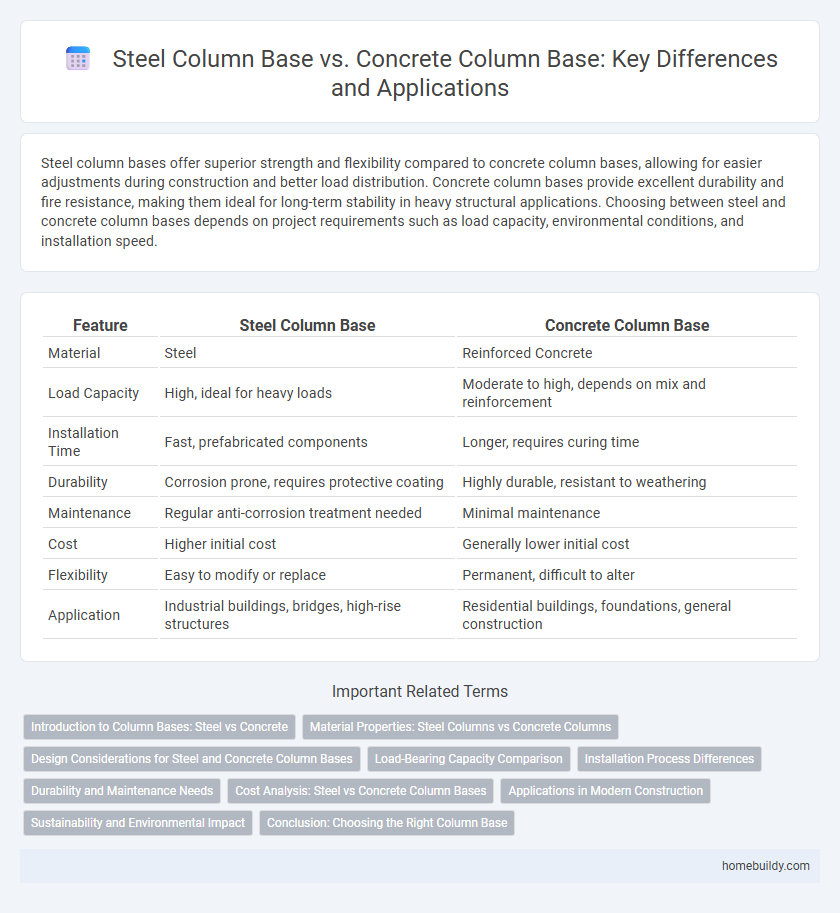Steel column bases offer superior strength and flexibility compared to concrete column bases, allowing for easier adjustments during construction and better load distribution. Concrete column bases provide excellent durability and fire resistance, making them ideal for long-term stability in heavy structural applications. Choosing between steel and concrete column bases depends on project requirements such as load capacity, environmental conditions, and installation speed.
Table of Comparison
| Feature | Steel Column Base | Concrete Column Base |
|---|---|---|
| Material | Steel | Reinforced Concrete |
| Load Capacity | High, ideal for heavy loads | Moderate to high, depends on mix and reinforcement |
| Installation Time | Fast, prefabricated components | Longer, requires curing time |
| Durability | Corrosion prone, requires protective coating | Highly durable, resistant to weathering |
| Maintenance | Regular anti-corrosion treatment needed | Minimal maintenance |
| Cost | Higher initial cost | Generally lower initial cost |
| Flexibility | Easy to modify or replace | Permanent, difficult to alter |
| Application | Industrial buildings, bridges, high-rise structures | Residential buildings, foundations, general construction |
Introduction to Column Bases: Steel vs Concrete
Steel column bases offer superior strength-to-weight ratios and precise load transfer capabilities compared to concrete column bases, making them ideal for high-rise and industrial structures. Concrete column bases provide excellent compressive strength and durability, commonly used in residential and low-rise applications due to their cost-effectiveness and ease of construction. Selection between steel and concrete bases depends on factors like structural load requirements, environmental conditions, and project budget constraints.
Material Properties: Steel Columns vs Concrete Columns
Steel column bases offer superior tensile strength and ductility compared to concrete column bases, enabling better performance under dynamic loads and seismic forces. Concrete column bases provide excellent compressive strength and mass, which enhances stability but lack the flexibility of steel under stress. The choice between steel and concrete bases depends on load requirements, environmental conditions, and structural design priorities.
Design Considerations for Steel and Concrete Column Bases
Steel column bases require precise load transfer design to ensure stability, factoring in bolt quality, base plate thickness, and weld strength. Concrete column bases demand careful evaluation of bearing capacity, reinforcement detailing, and anchorage to resist tension and shear forces. Both designs must account for soil conditions, load eccentricity, and potential settlement to maintain structural integrity.
Load-Bearing Capacity Comparison
Steel column bases typically offer higher load-bearing capacity due to their superior tensile strength and ability to resist bending under heavy loads. Concrete column bases provide substantial compressive strength but are more susceptible to cracking under tensile stress, which can limit their load-bearing performance in dynamic or uneven load conditions. Engineering assessments often recommend steel bases for structures requiring high load capacity and durability, while concrete bases are suitable for lighter or evenly distributed loads.
Installation Process Differences
Steel column bases require precise welding and bolting techniques for secure attachment to the steel columns, with components typically fabricated off-site and assembled on-site to ensure alignment and stability. Concrete column bases involve pouring and curing concrete around base plates anchored with embedded bolts, demanding extensive formwork, reinforcement placement, and longer curing times for full strength development. The installation of steel bases is generally faster with less downtime, while concrete bases require careful timing and sequencing due to curing requirements and heavy formwork assembly.
Durability and Maintenance Needs
Steel column bases offer superior durability with high resistance to corrosion and mechanical wear when properly coated, requiring less frequent maintenance compared to concrete bases. Concrete column bases are prone to cracking and spalling due to environmental exposure, necessitating regular inspections and repairs to maintain structural integrity. The long-term maintenance costs of steel bases are generally lower, making them preferable for projects demanding durability and reduced upkeep.
Cost Analysis: Steel vs Concrete Column Bases
Steel column bases generally offer higher upfront material and fabrication costs compared to concrete bases, but they reduce overall expenses through faster installation and lower labor requirements. Concrete column bases involve lower material costs but require more extensive formwork, curing time, and skilled labor, increasing project timelines and indirect expenses. Evaluating total cost efficiency, steel bases often prove more economical for projects prioritizing speed and reduced labor overhead, while concrete bases may be preferred for budget-sensitive applications with less stringent time constraints.
Applications in Modern Construction
Steel column bases provide superior load-bearing capacity and rapid installation, making them ideal for high-rise buildings and industrial structures where precision and strength are critical. Concrete column bases offer excellent durability and cost-efficiency, commonly used in residential buildings and infrastructure projects requiring robust foundation support. Modern construction favors steel bases in seismic zones due to their flexibility, while concrete bases dominate in projects prioritizing thermal mass and long-term stability.
Sustainability and Environmental Impact
Steel column bases offer recyclability and reduced material waste, enhancing sustainability by enabling easier disassembly and repurposing in construction projects. Concrete column bases tend to have higher embodied carbon due to cement production, contributing significantly to environmental impact through CO2 emissions. Utilizing steel bases supports circular economy principles while concrete bases require strategies like carbon capture or alternative cements to minimize ecological footprint.
Conclusion: Choosing the Right Column Base
Steel column bases offer superior strength, flexibility, and ease of installation, making them ideal for high-rise and industrial structures. Concrete column bases provide excellent stability and cost efficiency for low- to mid-rise buildings with less demanding load requirements. Selecting the right column base depends on the specific structural needs, load capacity, and project budget to ensure safety and durability.
steel column base vs concrete column base Infographic

 homebuildy.com
homebuildy.com